Need to Repair a Bowing Basement Walls? We Review Costs and Solutions
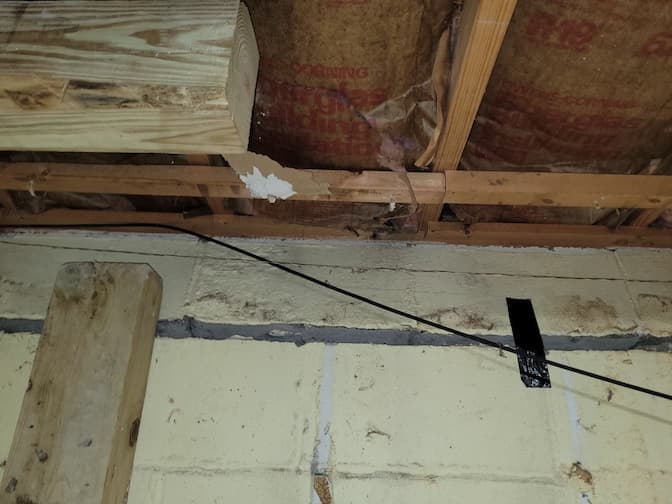
Originally posted 12/5/19, updated 12/14/22
When a basement wall cracks, it needs to be repaired, much like a broken bone. Having been broken, it must be set back in place and held firm to heal. Depending on how severe the break, it may take metal plates and pins for the bone to regain strength.
The solutions for a bowing basement wall are remarkably similar to this. And like a broken bone, you should seek professional help promptly. Bowing walls are not an area for a DIY repair; the methods and equipment required are well beyond the scope of a homeowner, no matter how skilled.
Since our start in 1996, Acculevel has helped more than 30,000 homeowners restore strength and stability to their homes. We are a family-owned and operated company that specializes in foundation repair and waterproofing.
In this blog, we’re going to explain what causes a basement wall to move, the best repair methods, and their respective costs.
Please Note: Fixing a bowing basement wall does not necessarily mean straightening it. The goal of the repair is to stabilize and secure it in place.
Why Is Your Wall Moving? Hydrostatic Pressure
Frequently, a bowing wall is caused by hydrostatic pressure. When the soil around your house is saturated with water, it forces the soil to expand and press against your foundation. These conditions are common in our service area (Indiana and the surrounding states) during snow melts and spring rains, but can also be caused by poor drainage around your house.
We recommend that whenever you clean your guttering, you evaluate it and your downspouts. These should be kept in good condition, because they’re the first line of defense against rainwater. Downspouts should drain at least 10 feet from your home. If they don’t, rainwater may be collecting around your foundation and contributing to the problem. If your guttering and downspouts “pass inspection,” you may need to install water drainage in your basement (in addition to repairing the bowing wall).
This is not something we suggest to make you spend more money. If you have significant water intrusion, only repairing the bowing wall is treating the symptom and ignoring the disease. If you don’t address the hydrostatic pressure, your home will continue to be vulnerable to its effects.
The contractor you hire should be reputable and experienced (of course!), but they should also be concerned about helping you prevent additional damage. Acculevel project advisors are expected to address your concerns, evaluate your home, and provide you with a whole-home solution.
Factors That Impact Bowing Wall Repair Costs
In the past 12 months, we’ve completed several hundred basement wall repairs; our customers paid an average of $6950-$8300 for these services. Three things will influence the overall cost of repairs to your home: how far has it bowed, what is outside of the wall, and how long the wall is. Each of these is contingent on which repair option you choose to use.
What Are My Repair Options?
Carbon Fiber Straps
Carbon Fiber Straps are our preferred method for repairing a bowing basement wall. They are the least invasive to install and usually the least expensive. However, these are best used for walls that are bowing inward 2 inches or less.
These straps are epoxy-sealed directly to the wall and secured at the top and bottom. Generally speaking, we need to place a strap every 4 feet along the wall. The installation can be done entirely from the inside of the basement, with no excavation required. Once the installation is complete, you can even paint over the straps if you’d like.
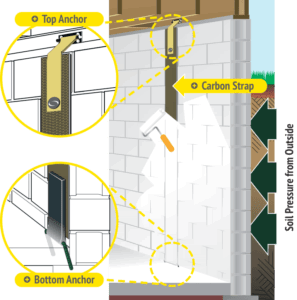 This is an illustration of Fortress Carbon Fiber Straps
This is an illustration of Fortress Carbon Fiber Straps
Wall Anchors
If your wall is bowing more than 2 inches, we consider wall anchors instead. These cost more than straps for two reasons. First, they require some excavation outside your home (to place the anchor). Second, anchors use steel components which are more expensive than straps.
You’ll need at least 10 feet of usable ground outside the basement to install an anchor. A steel plate or channel is attached to the basement wall. Another plate is buried in the yard, and the two are connected by a steel shaft.
As the steel rod is tightened, it exerts pull on the wall and the anchor in the yard holds it fast. Anchors should be placed about every 5 feet along the bowing wall.
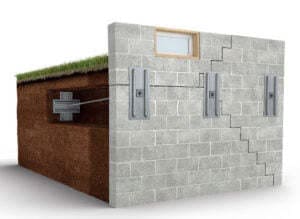 This is an illustration of Wall Anchors.
This is an illustration of Wall Anchors.
Helical Tiebacks
If your wall is bowing too much for straps, and the property arrangement doesn’t allow for anchors, helical tiebacks are the best option. These are the most secure method, but also the most expensive. A steel shaft with helical (screw-like) plates on the end is drilled at an angle through the earth outside of your foundation.
The shaft is secured to the inside of the basement wall with a large steel plate or channel, then twisted to a specific torque that holds it tight. Usually, tiebacks are 14-21 feet long, but in certain cases, longer lengths are required to get the proper “grip” on the soil.
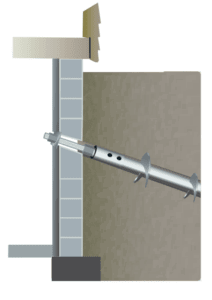 This is an illustration of a Helical Tieback.
This is an illustration of a Helical Tieback.
Wall Straightening
We mentioned earlier that repairing a bowed wall does not mean returning it to plumb. However, if you would prefer to have your previously bowed wall returned to its pre-bowing state, wall straightening is an option. For us at Acculevel, it is not a standard service because it is more invasive to your home and property, as well as being more expensive.
In order to straighten the wall, a contractor will excavate outside of your foundation to access the exterior of the wall. This alleviates the pressure on the foundation. Then using hydraulic jacks inside the basement, they’ll push the bowing wall back into position.
Once straightened, it is secured, usually by carbon fiber straps. Straightening the wall does not negate the need for straps- if the wall has failed once, it is likely to do so again at a later date if there’s no reinforcement to strengthen it.
Want to see how this process works? One of our customers recently had their wall straightened, so that they could install an egress window in it. (They also needed waterproofing.) You can see the entire process, step by step, in this article.
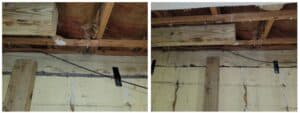 These pictures were taken by an Acculevel crew member. On the left is a basement wall that has cracked and is bowing inward. On the right is the same wall, after it’s been straightened to close the crack.
These pictures were taken by an Acculevel crew member. On the left is a basement wall that has cracked and is bowing inward. On the right is the same wall, after it’s been straightened to close the crack.
Want to Know the Costs to Fix YOUR Basement Wall?
Find an experienced local foundation company, and make an appointment. Before you sign a contract for any service, you should always verify the company is reputable, insured, and accredited by the Better Business Bureau.
If you live in Indiana or the surrounding states, contact Acculevel. Established in 1996, we specialize in foundation repairs. If you have noticed horizontal cracks in your basement, or if you have a bowing wall, you can request a free estimate. An experienced project advisor will evaluate your crawl space conditions and recommend the best course of action for you, to keep your home strong and healthy for years to come.
We have also created a free tool that any homeowner can use to see what could be causing problems in your home and how to fix it. Identify problems, explore solutions, and get advice on how and when to take action with our Symptom Checker.
